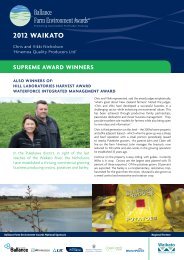Dairy's role in sustaining New Zealand - Fonterra
Dairy's role in sustaining New Zealand - Fonterra
Dairy's role in sustaining New Zealand - Fonterra
You also want an ePaper? Increase the reach of your titles
YUMPU automatically turns print PDFs into web optimized ePapers that Google loves.
12 Dairy’s <strong>role</strong> <strong>in</strong> generat<strong>in</strong>g growth<br />
2.5 How we analyse the modell<strong>in</strong>g results<br />
In analys<strong>in</strong>g the modell<strong>in</strong>g results we take a systematic approach of track<strong>in</strong>g the impacts as<br />
they flow through the economy, beg<strong>in</strong>n<strong>in</strong>g with the direct impacts on the dairy sector itself.<br />
We look at the export and domestic markets, and how the sector responds to growth with<br />
<strong>in</strong>creased employment and <strong>in</strong>vestment.<br />
We then analyse the flow-on or <strong>in</strong>direct impacts on other <strong>in</strong>dustries. We split <strong>in</strong>direct impacts<br />
<strong>in</strong>to the follow<strong>in</strong>g <strong>in</strong>dustry categories:<br />
• Supply<strong>in</strong>g <strong>in</strong>dustries – <strong>in</strong>dustries that supply dairy with <strong>in</strong>termediate <strong>in</strong>puts are likely to<br />
benefit from a stronger dairy sector. These are <strong>in</strong>dustries such as agricultural services and<br />
the fertilizer <strong>in</strong>dustry.<br />
• Household expenditure <strong>in</strong>dustries – <strong>in</strong>dustries that households spend money on are<br />
likely to benefit from <strong>in</strong>creased <strong>in</strong>come that comes through higher employment and<br />
wages, and <strong>in</strong>creased returns to capital from a grow<strong>in</strong>g dairy sector.<br />
• Government <strong>in</strong>dustries – <strong>in</strong>dustries that rely on government fund<strong>in</strong>g are positively<br />
impacted by a stronger economy and bigger tax takes, as this <strong>in</strong>creases the money<br />
available for the government to spend.<br />
• Compet<strong>in</strong>g export <strong>in</strong>dustries – <strong>in</strong>dustries that compete for resources (such as land and<br />
labour) with the dairy sector lose from dairy’s growth.<br />
F<strong>in</strong>ally, we exam<strong>in</strong>e the macroeconomic effects. Here we report both value-add (GDP) and<br />
Net Economic Benefit/welfare (private and public consumption) measures.<br />
There are two ways to th<strong>in</strong>k about the way that export growth will affect GDP:<br />
(i) GDP is the sum of the value of expenditure on goods and services made <strong>in</strong> <strong>New</strong><br />
<strong>Zealand</strong> and exports are a component of that expenditure, so a change <strong>in</strong> exports<br />
directly affects the level of GDP. The change <strong>in</strong> exports will then have flow-on effects<br />
on other parts of the economy, as described <strong>in</strong> our results section.<br />
(ii) GDP is also the sum of the value of resources utilised <strong>in</strong> the economy. Increased dairy<br />
exports are generated, <strong>in</strong> part, by ga<strong>in</strong>s <strong>in</strong> productivity. Greater productivity allows<br />
the same resources – capital, land and labour – to generate greater value, so GDP<br />
<strong>in</strong>creases as productivity rises. Thus we expect export growth to have a direct impact<br />
on GDP and, <strong>in</strong> the long run, a positive impact.<br />
Although GDP is the most commonly used measure of economic performance, it does<br />
not capture necessarily how ‘well off’we are as a country. GDP is essentially a measure of<br />
how many goods and services <strong>New</strong> <strong>Zealand</strong> produces – it shows the size of the economy.<br />
Consumption shows how much household and government spend<strong>in</strong>g <strong>in</strong>creases follow<strong>in</strong>g<br />
a change <strong>in</strong> the economy. It is more appropriate than GDP as a measure of welfare (see<br />
Coleman, 2008), particularly <strong>in</strong> cases where we expect changes <strong>in</strong> the terms of trade 7 .<br />
Ultimately, the objective of an economic development is to raise the liv<strong>in</strong>g standards of the<br />
population. Liv<strong>in</strong>g standards are better proxied by household and government spend<strong>in</strong>g<br />
ability than by GDP. Thus our preferred NEB/welfare measure is consumption. Our CGE model<br />
allows us to determ<strong>in</strong>e, once all <strong>in</strong>ter-<strong>in</strong>dustry effects and factor price changes have occurred,<br />
the additional boost to <strong>New</strong> <strong>Zealand</strong>’s GDP and NEB/welfare result<strong>in</strong>g from a price change<br />
<strong>in</strong> the milk solids payout or volume growth <strong>in</strong> the sector. In addition, we also report other<br />
macroeconomic <strong>in</strong>dicators such as wages and employment.<br />
7. We use the term ‘welfare’here not <strong>in</strong> the technical economic sense but merely as a synonym for ‘wellbe<strong>in</strong>g’. The claim is merely that<br />
changes <strong>in</strong> consumption better proxy changes <strong>in</strong> welfare than do changes <strong>in</strong> GDP. We do not claim to actually measure welfare <strong>in</strong><br />
the technical sense.
















